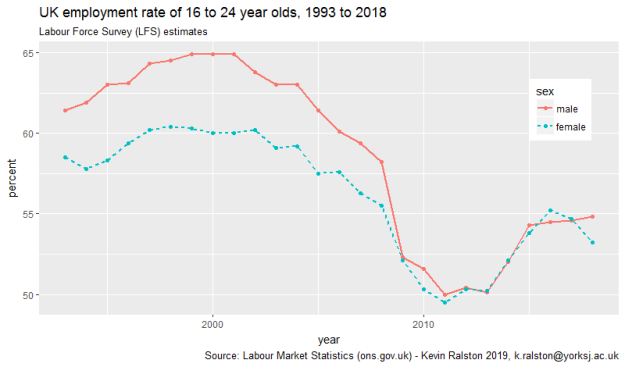Kevin Ralston 2019, York St John University
This series of posts will apply nationally collected, representative data to highlight some of the trends underlying the official employment rate.
This current post employs data from the Labour Force Survey, Labour Market Statistics to chart the youth employment rate. The data are freely available from the Office for National Statistics (ONS) and the UK data service.
Figure 1 (available here)

The UK Government has been celebrating what is described as a record high employment rate. The most recent employment rate estimate is at 75.8%. It seems to be unalloyed good news. Yet a high employment rate is only part of the story. The high top-line level of employment has been underscored by stagnating wages and increasing levels of extreme poverty. People have paid work, but many are still getting poorer.
Figure 1 illustrates that this high level of employment is not experienced equally by all groups. The youth employment rate is only 54%. The male youth employment rate is around ten percent lower than it was in 2001. The female youth employment rate is around seven percent lower than it was 2001.
The youth labour market was collapsing from 2001-2002. The Figure also indicates just how catastrophic the Great Recession of 2008 was for young people’s employment prospects.
The chances of young men and women making an early transition into the labour force has declined substantially in the last twenty years. This is worth bearing in mind when you see it asserted that the UK employment rate is high. It is, but there are substantial problems underlying the top-line trend.
Technical note:
The data from 1993 to 2017 were published by ONS as Labour Market Statistics. This did not, at time of writing, include information for 2018. The 2018 figure was taken from the first three quarters of the 2018 Labour Force Survey. In estimating the rate the individual person weight [PWT17] was applied.
The code to generate the graph and the data are available on GitHub
